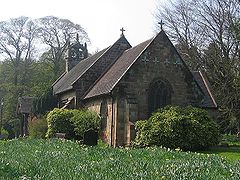Cofton Hackett
| Cofton Hackett | |
|---|---|
 Cofton Church of St Michael built c. 1330, November 2005 |
|
| Cofton Hackett shown within Worcestershire | |
| Population | 1,747 (2001) |
| OS grid reference | SP010750 |
| Civil parish |
|
| District | |
| Shire county | |
| Region | |
| Country | England |
| Sovereign state | United Kingdom |
| Post town | BIRMINGHAM |
| Postcode district | B45 |
| Dialling code | 0121 |
| Police | West Mercia |
| Fire | Hereford and Worcester |
| Ambulance | West Midlands |
| EU Parliament | West Midlands |
| UK Parliament | |
Cofton Hackett is a village and civil parish in the Bromsgrove District of north east Worcestershire, England. It is 10.3 miles (16.5 kilometres) southwest of the city centre of Birmingham and 16 miles (25.7 kilometres) northeast of Worcester. The village has a population 1,747.
Cofton Hackett is an ancient settlement mentioned in historical documents dating back to 780 AD. Coſtune (Costune) was among places granted by King Offa to the minster of St Peter, Bredon in 780. The bounds for this estate probably covered the parishes of Alvechurch and Cofton.
The spelling of the name has varied over the centuries: for many centuries, the usual spelling was Coston. However, the old form of the letter "S" in the middle of words, ‹ ſ ›, was only at some point in the last hundred years misread as a lower case "F", thus turning ‹Coſton› (Coston) into the present-day ‹Cofton›. William de Haket is known to have held ‹Coſa› (Cosa) in 1166. His family name was later added to ‹coſa tun›, which in Anglo-Saxon meant 'cosy farm'. In modern parlance the word 'cove' has a similar derivation and is generally used to describe a sheltered coastal feature, but equally referred to any sheltered spot. The name of the manor transformed over the centuries into Coston Hackett and is usually recorded as such from the 11th century and well into the early 20th. The final permanent change to Cofton appears to have taken place sometime between 1913 and 1930 based on direct comparisons between the Ordnance Survey maps of those dates.
Historically, Cofton Hackett was part of the upper division of Halfshire Hundred that also contained Bromsgrove, Dodderhill, Doverdale, Droitwich, Elmbridge, Feckenham, Hadsor, Hampton Lovett, Kington, Kings Norton, Northfield, Salwarpe, Tardebigge and Upton Warren.
...
Wikipedia

